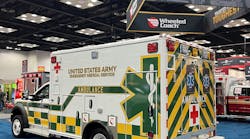I still vividly remember TV commercials for Miller Lite beer that aired years ago. The ads featured many well-known names, such as comedian Rodney Dangerfield and former NFL coach and commentator John Madden. Other sports celebrities in the ads included football players Bubba Smith and Dick Butkus and baseball manager Billy Martin. Usually, two of them would banter back and forth and eventually have a shouting match over whether the beer tasted great or was less filling. They could never agree.
Not long ago, I heard a similar discussion that did not end in a shouting match, but everyone in the room definitely had their opinion. The question being debated was whether the true measure of the success of an EMS system is based on response times or patient outcomes. Some argued that getting to the patient makes all the difference, while those on the other side of the debate contended it is patient outcomes – the patient walking out of the hospital is the true measure of how successful an EMS system is.
Making a difference?
As I listened to the arguments and discussion go back and forth, I wondered how many of the calls we go on make any difference at all. After all, how many calls do we go on for which we could have showed up an hour later, did nothing but give the patient a ride to the hospital and they would walk out of the hospital later that afternoon with a prescription in their hand? But I am sure the debate centered on those 10% to 20% of the patients we see who truly need some type of emergency medical intervention that determines whether they live or die or have some other permanent condition as a result of an accident or medical event.
I’ve seen private ambulance companies market themselves as a high-performance EMS system. What does that mean? Are they trying to compare themselves to the airline industry when it comes to on-time departures and arrivals? Translated, I think it mainly means that if you work for a private ambulance company, mostly in a Public Utility Model, you will find yourself sitting on a parking lot at the local 7-Eleven waiting for a run. It’s no different than staggering the floors on which elevators are staged in a 50-story building at 5 P.M. to minimize the time people must wait for an elevator when leaving work. It’s the same principle and the same concept.
So what about response times versus patient outcomes? Does one have value or more importance than the other?
Some will argue that you can arrive late as long as you perform exemplary medicine and the patient has a good outcome. Others contend that seconds can count and it does not matter what type of paramedic skills you have – if you do not arrive at the scene in an expedient time, the patient will have a bad outcome. The proverbial argument they use is that biological brain death can occur in six minutes for someone who does not have oxygen circulating. (On a side note, I have always wondered why, if brain death occurs in six minutes, it is acceptable to have a response time of eight minutes or less for an ambulance 90% of the time. We can only pray the community has a first responder that can get there in six minutes or less.)
When I do some research, I find quite a few studies that show that response time does not matter in patient outcomes. Some studies even hypothesize and recommend that we can turn off the lights and sirens. Tell that to the man who is choking on his roast beef sandwich and turning blue. I bet he does not care about the studies. Of course, the principal researchers of all these studies have credentials after their names, but of them say EMT-P. They are mainly researchers who have never worked on an ambulance or fire truck and primarily crunch numbers on their computers.
There is no doubt that there is a public expectation that when they hang up after speaking with the 911 dispatcher, they expect someone to fly into the scene with lights flashing and the siren blaring. After all, that is how it is done on TV. Can you imagine watching a show that is on for one hour, but there are really only 45 minutes of programming because of commercials and only eight minutes show an ambulance or engine driving to the scene with lights and siren?
I may receive feedback from those would debate me on this point, but I believe there is nothing wrong with a rapid response time and quality care being delivered to the same patient. Who says we have to pick one or the other? Why can’t an engine or ambulance arrive relatively quickly and why can’t the crew deliver high-quality care also? Is there something wrong with having both?
I think not! Most fire departments that operate in urban and suburban communities are in a position to have fast response times along with delivering quality care. Fast response times and quality care are the hallmarks of an excellent fire-based EMS system.
For more news and training on EMS, visit http://EMSWorld.com/.






